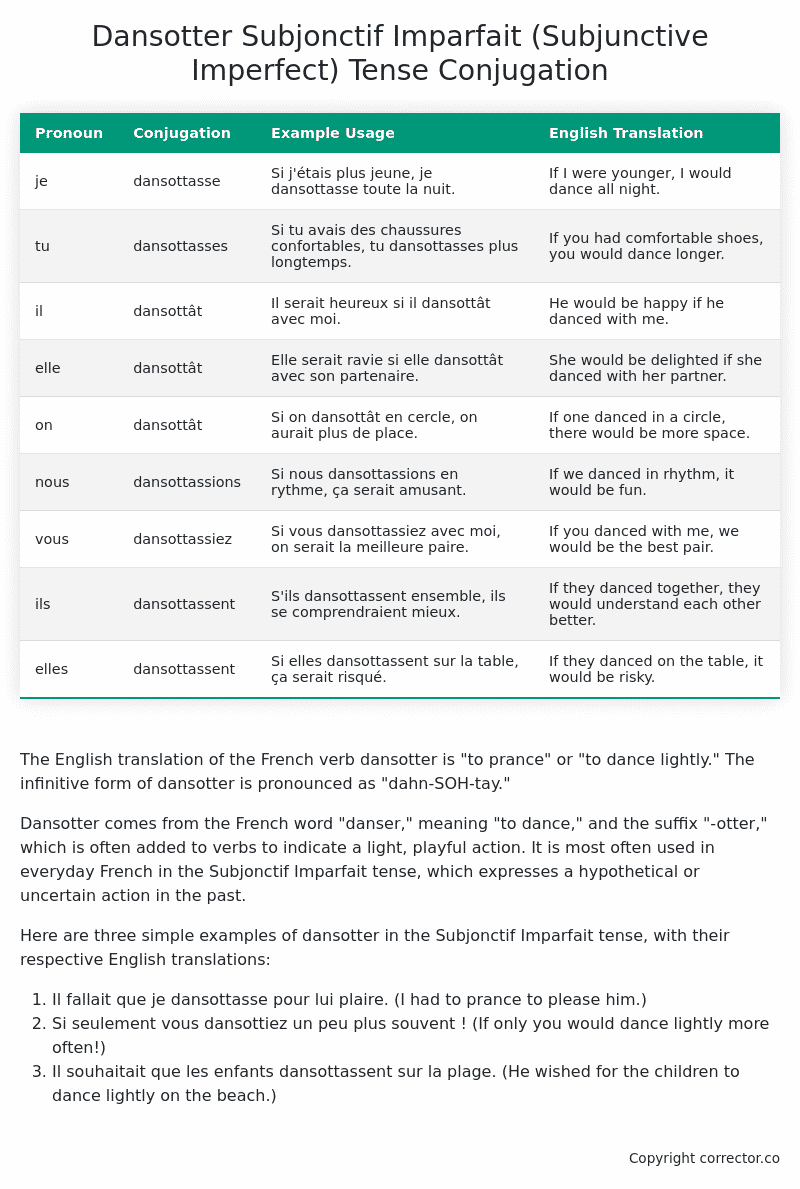Subjonctif Imparfait (Subjunctive Imperfect) Tense Conjugation of the French Verb dansotter
Introduction to the verb dansotter
The English translation of the French verb dansotter is “to prance” or “to dance lightly.” The infinitive form of dansotter is pronounced as “dahn-SOH-tay.”
Dansotter comes from the French word “danser,” meaning “to dance,” and the suffix “-otter,” which is often added to verbs to indicate a light, playful action. It is most often used in everyday French in the Subjonctif Imparfait tense, which expresses a hypothetical or uncertain action in the past.
Here are three simple examples of dansotter in the Subjonctif Imparfait tense, with their respective English translations:
- Il fallait que je dansottasse pour lui plaire. (I had to prance to please him.)
- Si seulement vous dansottiez un peu plus souvent ! (If only you would dance lightly more often!)
- Il souhaitait que les enfants dansottassent sur la plage. (He wished for the children to dance lightly on the beach.)
Table of the Subjonctif Imparfait (Subjunctive Imperfect) Tense Conjugation of dansotter
| Pronoun | Conjugation | Example Usage | English Translation |
|---|---|---|---|
| je | dansottasse | Si j’étais plus jeune, je dansottasse toute la nuit. | If I were younger, I would dance all night. |
| tu | dansottasses | Si tu avais des chaussures confortables, tu dansottasses plus longtemps. | If you had comfortable shoes, you would dance longer. |
| il | dansottât | Il serait heureux si il dansottât avec moi. | He would be happy if he danced with me. |
| elle | dansottât | Elle serait ravie si elle dansottât avec son partenaire. | She would be delighted if she danced with her partner. |
| on | dansottât | Si on dansottât en cercle, on aurait plus de place. | If one danced in a circle, there would be more space. |
| nous | dansottassions | Si nous dansottassions en rythme, ça serait amusant. | If we danced in rhythm, it would be fun. |
| vous | dansottassiez | Si vous dansottassiez avec moi, on serait la meilleure paire. | If you danced with me, we would be the best pair. |
| ils | dansottassent | S’ils dansottassent ensemble, ils se comprendraient mieux. | If they danced together, they would understand each other better. |
| elles | dansottassent | Si elles dansottassent sur la table, ça serait risqué. | If they danced on the table, it would be risky. |
Other Conjugations for Dansotter.
Le Present (Present Tense) Conjugation of the French Verb dansotter
Imparfait (Imperfect) Tense Conjugation of the French Verb dansotter
Passé Simple (Simple Past) Tense Conjugation of the French Verb dansotter
Passé Composé (Present Perfect) Tense Conjugation of the French Verb dansotter
Futur Simple (Simple Future) Tense Conjugation of the French Verb dansotter
Futur Proche (Near Future) Tense Conjugation of the French Verb dansotter
Plus-que-parfait (Pluperfect) Tense Conjugation of the French Verb dansotter
Passé Antérieur (Past Anterior) Tense Conjugation of the French Verb dansotter
Futur Antérieur (Future Anterior) Tense Conjugation of the French Verb dansotter
Subjonctif Présent (Subjunctive Present) Tense Conjugation of the French Verb dansotter
Subjonctif Passé (Subjunctive Past) Tense Conjugation of the French Verb dansotter
Subjonctif Imparfait (Subjunctive Imperfect) Tense Conjugation of the French Verb dansotter (this article)
Subjonctif Plus-que-parfait (Subjunctive Pluperfect) Tense Conjugation of the French Verb dansotter
Conditionnel Présent (Conditional Present) Tense Conjugation of the French Verb dansotter
Conditionnel Passé (Conditional Past) Tense Conjugation of the French Verb dansotter
L’impératif Présent (Imperative Present) Tense Conjugation of the French Verb dansotter
L’infinitif Présent (Infinitive Present) Tense Conjugation of the French Verb dansotter
Struggling with French verbs or the language in general? Why not use our free French Grammar Checker – no registration required!
Get a FREE Download Study Sheet of this Conjugation 🔥
Simply right click the image below, click “save image” and get your free reference for the dansotter Subjonctif Imparfait tense conjugation!

Dansotter – About the French Subjonctif Imparfait (Subjunctive Imperfect) Tense
Formation
Common Everyday Usage Patterns
Interactions with Other Tenses
Subjonctif Présent
Indicatif Passé Composé
Conditional
Conditional Perfect
Summary
I hope you enjoyed this article on the verb dansotter. Still in a learning mood? Check out another TOTALLY random French verb conjugation!


